David Patrikarakos, Inside Ukraine’s Nonviolent Resistance: Chatbots, Yellow Paint, and Payoffs- The Atlantic
How Ukraine’s digital resistance fights behind Russian lines
The man introduced to me in the southern port city of Odesa as Taras does not look like what he is: the founder of the civilian resistance to Russia’s military occupation of southern and eastern Ukraine. He’s no tough Marshal Tito or ethereal Mahatma Gandhi. He looks, in fact, like your typical Gen Z tech worker: early 20s, lean, trendy—and he’s always online. He likes to talk about English Premier League football games from the 1980s, but only because he’s seen them on YouTube; he can name scores of Premier League players, but only because he’s used their avatars in the FIFA video game. He adores Instagram.
Since April, Taras has led a group named Yellow Ribbon, which took up the principles of nonviolent resistance soon after the Russians overran his home city of Kherson. (Taras is a pseudonym he uses to help protect his identity from his Russian enemies.) Its goal: to resist Russian occupation through peaceful means wherever possible. The group has now spread throughout the occupied territories of Ukraine, and as it has done so, its reputation has grown. Late last year, Yellow Ribbon was one of four Ukrainian groups honored with the European Parliament’s Andrei Sakharov Prize for Freedom of Thought, the European Union’s main award for the defense of human rights.

What distinguishes Yellow Ribbon from traditional nonviolent resistance movements is its emphasis on the digital. The group’s growing numbers of activists stay connected via a chatbot plugin on the group’s Telegram messaging app. Prompted by the chatbot’s automated questions, activists in the occupied territories can access various resistance tasks to carry out on the ground. The system enables Yellow Ribbon to share the materials and techniques necessary for the resistance to make its activities visible in the real world of the occupation, while safeguarding the anonymity of the participants against Russian efforts to penetrate the network. Among the clandestine actions guided by the chatbot are scrawling pro-Ukraine graffiti, tying yellow ribbons around objects in the streets, and projecting slogans onto buildings taken over by the Russian administration. Such nonviolent actions have made Yellow Ribbon famous across Ukraine—and a serious problem for Russia in the occupied areas.
At first, the Russians ignored the group to avoid amplifying its work. Eventually, as Yellow Ribbon’s activities grew, they were forced to respond. Yellow and blue paint began to disappear from shops in occupied areas. Buying anything yellow became almost impossible; people were reduced to cutting patches of the color out of old clothes.
Even Russian soldiers began to feel the effects of Yellow Ribbon’s activities. Taras told me that after graffiti appeared near the entrance of a Chechen base in Melitopol, another occupied city in southeastern Ukraine, the soldiers changed their location and started going about town in civilian clothing rather than military uniform.
Access to the Telegram chatbot has allowed resistance activists to spring up across the occupied territories; many of them were women, who, I was told, could more easily pass unnoticed by the Russian occupiers. Earlier this year, I met Liliyia Aleksandrova in Kherson, which was recaptured by Ukrainian forces late last year—though artillery shelling still roared in the background as we spoke. Prior to the occupation, Aleksandrova had, she said, been a middle-aged “mama.” When the Russians first came to Kherson, she attended some street demonstrations, but the tear gas and soldiers soon put a stop to things. “It was clear we couldn’t protest publicly anymore,” she told me. “I was thinking about what I could do for my country; I had to do something to be useful.”
On Telegram, she came across Yellow Ribbon and, using the group’s chatbot tool, she began downloading instructions for tasks. She put up yellow ribbons everywhere she could—on buildings, lampposts, and fences—and took photos. Once or twice, she was almost caught, but she continued. Her work was everywhere around the city. As we talked, we passed Yellow Ribbon graffiti on a street wall. “I did that,” Liliyia told me with quiet satisfaction.




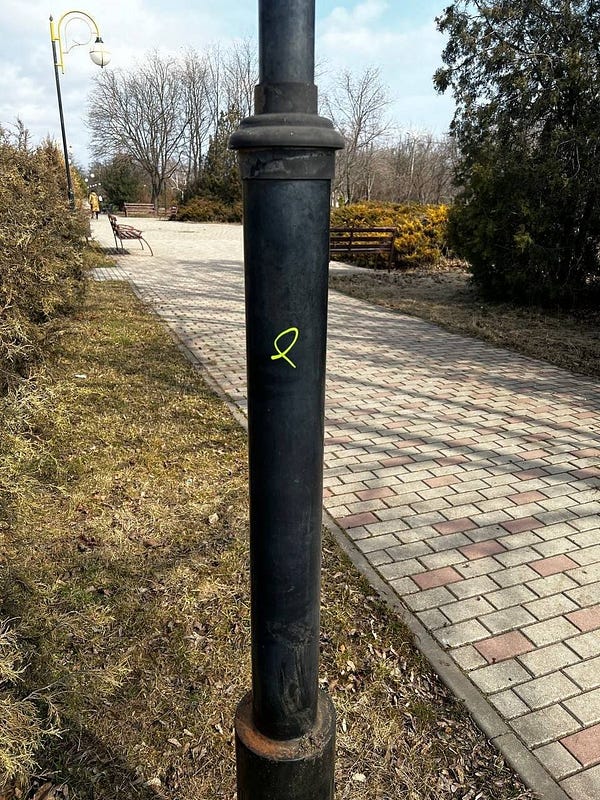
The first time Taras saw the Russians after the February 24 invasion, they had taken an office in the city’s main square; then they took the main police station. By March 2, they were in full control of Kherson. “No one knew what would happen tomorrow or the day after,” he told me when we met earlier this year in Odesa. He’d spent most of last year living under occupation in Kherson before its liberation in November.
Ukrainian partisans have launched sporadic attacks in Russian-occupied areas, but Taras had no military training, so any resistance activity he took on had to be nonviolent. He drew inspiration from earlier causes such as Germany’s White Rose student group, which opposed the Nazis; the U.S. civil-rights movement; and Czechoslovakia’s 1989 protests that led to the Velvet Revolution. Gandhi called nonviolent resistance “mightier than the mightiest weapon of destruction devised by the ingenuity of man.”
According to Erica Chenoweth and Maria J. Stephan, both political scientists and co-authors of the 2011 book Why Civil Resistance Works, taking up arms has traditionally given regime opponents a 26 percent chance of succeeding in their aims, whereas the tactics of nonviolent resistance have a 53 percent success rate. Countries where nonviolent, rather than violent, resistance led to change were more likely to remain democratic after the crisis ended.
Taras knew many people who wanted to act but for whom armed resistance was not an option. He could, he calculated, attract many more recruits through nonviolence. Almost anyone can participate: Its methods are highly accessible, and no specialist equipment or skills are required. He grasped that nonviolence’s main advantage over violence is scale—the number of people it can rally to a cause is exponentially greater.
Taras knew he could count on the 10 employees of the IT company he ran in Kherson, plus some people in other companies he worked with. This was enough to form the basis of what would become Yellow Ribbon. Even today, the core group of coordinators remains small—about 40 people, all of them known personally to Taras from before the occupation. Most are in their 20s.
At first, the Russians allowed residents of Kherson to protest in person, and many did, going to the central square, waving Ukrainian flags, and demanding the troops leave. Pooling cash, Taras’s group decided to buy online advertisements to spread the message. It gravitated easily from organizing IT projects to rallying support for the local protests and other pro-Ukraine activities through March and into April.

Then, in late April, a rumor spread through the city that Russia was making preparations for fraudulent referendums in occupied cities across the south. The result would be a foregone conclusion; the territories would be annexed to Russia. The resistance activists knew they had to act.
On April 23, they set up a Telegram group that they named Yellow Ribbon, a reference to the color on the Ukrainian flag, to spread pro-Ukraine messages and encourage people to paste leaflets and posters around Kherson. The platform would also work with local media to promulgate similar messages. Taras realized they could now reach hundreds of thousands of people.
“That’s what you can do with a digital component: reach larger audiences, spread more messages, get people to go out and protest, and do so successfully,” he told me. “We saw it work; things started to build like a snowball.”
The first demonstration, which took place on April 27, was modest in size—maybe 500 people. The Russians were out in force and used tear gas and stun grenades against the protesters. The physical demonstration may have been small, and was quickly put down, but online, via the Telegram channel and on social networks, it went viral. Moscow did eventually hold the referendum, but not until the end of September.





Another protest was planned for May 9, by which time things were getting more dangerous. Within five minutes, the protest was broken up by Russian forces. After the FSB, Russia’s state security police, came to town, the first local collaborators emerged, and activists started to disappear. Taras and his team made the decision to shift their strategy away from street demonstrations. If the resistance could not occupy the streets, it would occupy the online space.
In June, the group used Instagram to create a virtual street protest that included images of flags and banners on a visualization of a street in Kherson. Every person who attended had to write “Kherson is Ukraine” in the comments section. From these posts, the group calculated that 40,000 people had joined from Kherson and 16,000 from Mariupol. The Yellow Ribbon message spread across not only pro-Ukraine but pro-Russia platforms as well.
As Yellow Ribbon’s name and activities grew, new problems arose. Its activists were in constant danger of arrest. The group put several security protocols in place. Unlike specialized messaging platforms such as Signal, Telegram was already in widespread use by Ukrainians and Russians alike, rendering the app’s presence on a phone unsuspicious. Telegram can also be deleted from a phone, removing all the messages, and then downloaded again—with all of the messages still intact.
Getting people out of jail became a priority for the group. That generally meant one thing: bribes. Usually, it was easy to pay Russian soldiers or local collaborators to release an activist who’d disappeared. Taras knew businessmen in the city who had dealings with the Russians, and he used them as intermediaries. He’d pay them, and they’d pay the Russians.
Then, in late September, the group set up the chatbot. The technology enabled Yellow Ribbon to radically scale up its activities, allowing it to evolve from being a local resistance movement into something more powerful: a franchised one. People like Aleksandrova began to open cabinets across the occupied territories—in Melitopol and Donetsk and Luhansk, even in Crimea.
Over coffee in Odesa, Taras showed me the chatbot homepage on his laptop. In Crimea, chatbot volunteers tied a yellow ribbon on a tree near a shipping port. In September, leaflets announcing crimea is ukraine! and opening soon! were pasted on a government building there. Ukrainian-flag graffiti appeared in Donetsk, and in Melitopol posters mocked the Russian passports that locals were being pressured to get.



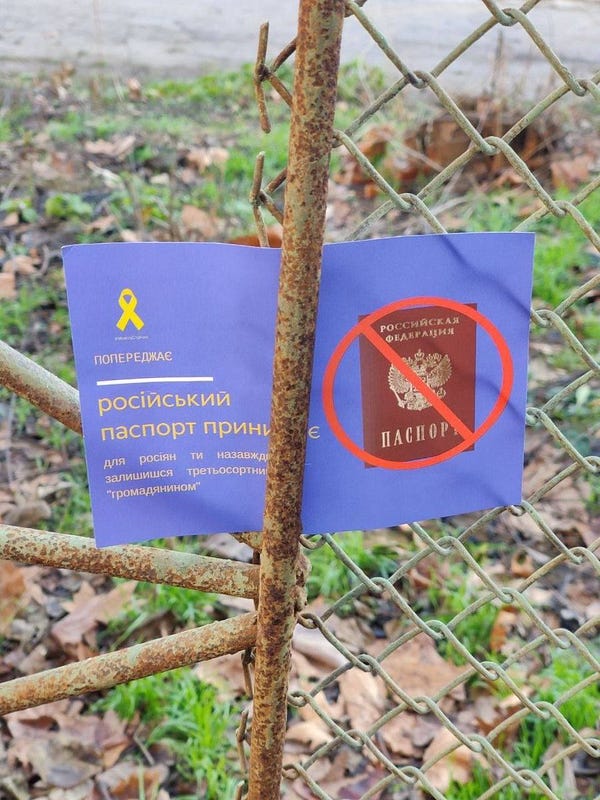
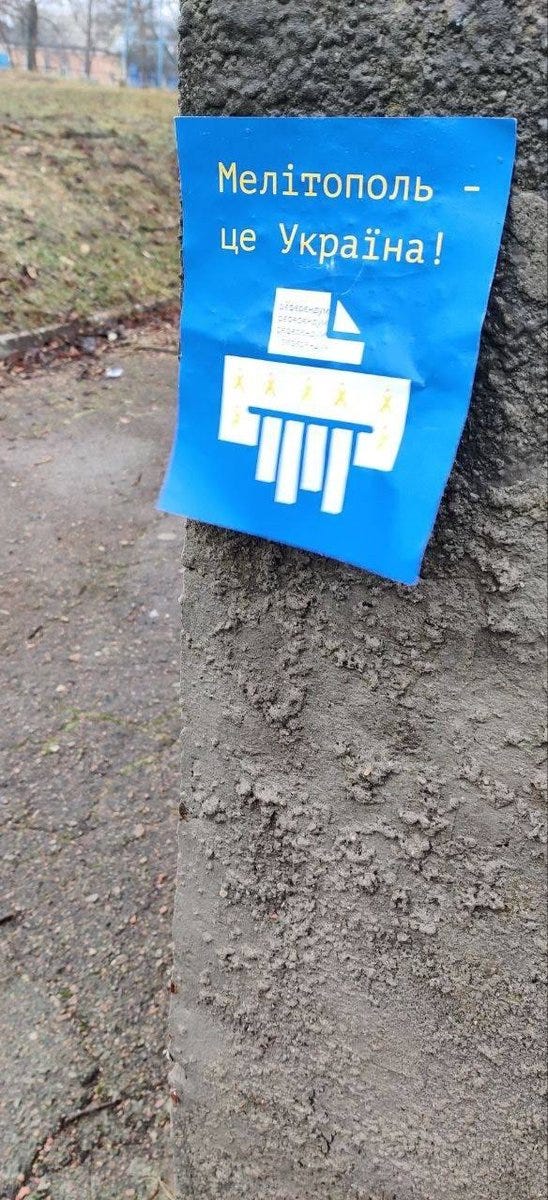
The group also taught people how to make stencils in the shape of the “3CY” initialism for the Ukrainian Armed Forces, and, using torches, project them onto official buildings. In late January, one appeared on the Russian administration’s office in Melitopol.
Most of the time, the group judged, Russian soldiers hadn’t themselves seen the resistance graffiti or leaflets in the city, but a monitoring team would report the photo of it that subsequently appeared online. Back in May, the Russian TV channel Izvestia paraded some purported Yellow Ribbon activists from Mariupol, who claimed that they had been paid to put up leaflets (as an alternative to other hourly paid work, which encouraged Russian viewers to infer that they were prostitutes).
The Yellow Ribbon team started noticing people whom it suspected were FSB personnel using the Chatbot app to pose as activists and request to meet in person—a clear violation of security rules. The team’s members, Taras told me, also received phishing links almost daily. In this sense, the digital amplification has increased the reach and impact of the ground activity, forcing the occupier to respond to it.
Eventually, the group’s presence attracted attention in Moscow. Yellow Ribbon’s work prompted a “concerned citizen” in Crimea to message the local Russian Investigative Committee’s Telegram channel: “I request you begin investigating the terrorist activities and spreading of ideology by the Yellow Ribbon group.” On January 27, the Ministry of Internal Affairs in Moscow issued a letter saying that the activity was being investigated, and two days later, a subdivision of the ministry confirmed that it was now regarded as a criminal matter.
Crimea against "Z" The opposition of the Ukrainian people is growing every day. Activists of the "Yellow Ribbon" movement in Crimea are turning "Z" symbols into hourglasses, which means only one thing - the time of occupation is running out. The time of freedom is coming!

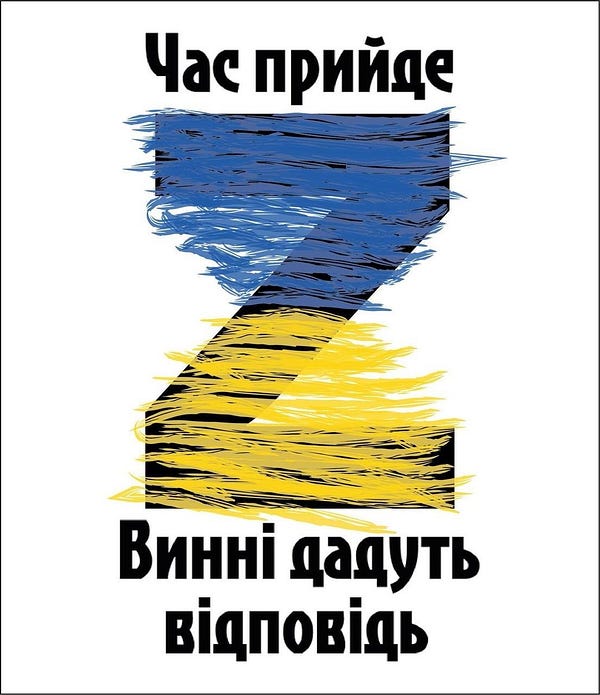



A Russian organization calling itself the Committee for the Defense Against Traitors released a video claiming that the group was engaged “in the information war” to push the agenda of “terrorists.” These sorts of attacks are only to be expected: The group’s activities are not just a constant reminder that the locals reject the occupation but also a living rebuttal of Russia’s entire narrative justifying its invasion.
Recently, I spoke with Ivan, a colleague of Taras’s who helped set up Yellow Ribbon back in April last year. (Again, I am using a pseudonym to protect his identity.) Another Kherson native, he is Yellow Ribbon’s main coordinator. When the Russians withdrew from the city, he went to nearby Melitopol, which remains under Moscow’s control. Ivan stayed behind enemy lines, he explained, because the group needs to ensure that the movement keeps growing, especially in that city and other still-occupied areas. It’s hard to find the right materials and places to print, and they need to keep their network of activists in play across the region.
“Things in Melitopol are tough,” he told me over an encrypted voice call. “The Russians have instituted an ‘anti-terrorist’ regime on the streets, which means increased patrols and video cameras everywhere. A lot of soldiers have arrived from Russia—and they are making a lot of arrests. It’s hard for us to work here now.
“The Russians can be brutal,” he went on. “But it depends on what unit they’re from—the Chechens are really bad. They think that this is their territory.”


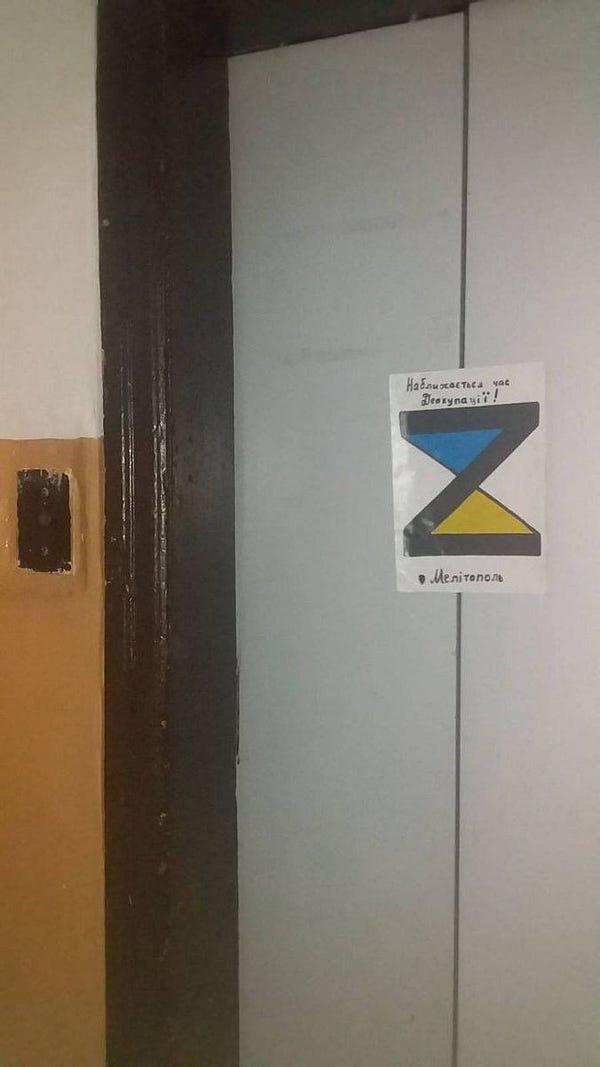

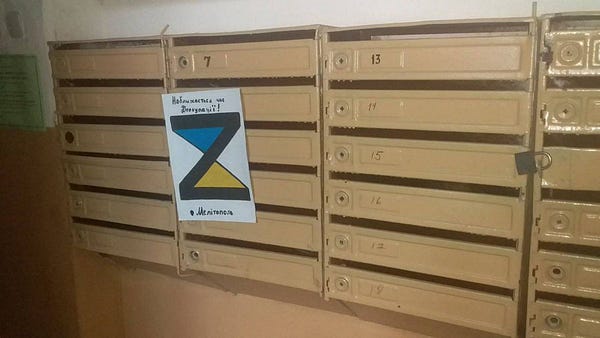
Ivan and his fellow activists keep a low profile, especially when they go out to buy necessities. Security is paramount. “I try not to be too active on the streets but instead focus on how to bring in the materials into the city and where to hide them,” he told me. “I work with VPNs and hosts and proxies to make sure my internet connection is safe. I have five cellphones and move from safe house to safe house each night or week.”
Taras left Kherson last August, before the city was liberated. He traveled by car, carrying just one sports bag and about 170,000 roubles (approximately $2,300), which he gave to the soldiers manning a checkpoint out of the city. When he handed over the cash, he felt like telling them they were welcome to it because he’d never be needing roubles again, but he refrained, and instead drove through the barrier in silence, back into free Ukraine.
Since then, he has continued to coordinate Yellow Ribbon’s activities from inside Ukraine. The group plans to expand its activities. The chatbot now serves about 4,600 open cabinets, but the group hopes to get that number to 100,000. This has helped change the nature of nonviolent resistance movements, which in the past tended to center on a single, charismatic figure, such as Martin Luther King Jr. or Gandhi. Instead, Yellow Ribbon, with its army of activists across occupied Ukraine, creates impact through a shared disgust at what Russia is doing, unifying opposition to the occupation. Its great strength lies in its digitally diffuse activism—which makes stopping it much harder for the Russians.
“I hope that liberation will come in the next three months,” Ivan said at the end of our conversation. “When it does, we will take our Ukrainian flags to the main square and celebrate with our military, as we did in Kherson.”




